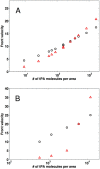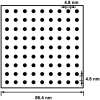Molecular and Physical Mechanisms of Fibrinolysis and Thrombolysis from Mathematical Modeling and Experiments
- PMID: 28785035
- PMCID: PMC5547096
- DOI: 10.1038/s41598-017-06383-w
Molecular and Physical Mechanisms of Fibrinolysis and Thrombolysis from Mathematical Modeling and Experiments
Abstract
Despite the common use of thrombolytic drugs, especially in stroke treatment, there are many conflicting studies on factors affecting fibrinolysis. Because of the complexity of the fibrinolytic system, mathematical models closely tied with experiments can be used to understand relationships within the system. When tPA is introduced at the clot or thrombus edge, lysis proceeds as a front. We developed a multiscale model of fibrinolysis that includes the main chemical reactions: the microscale model represents a single fiber cross-section; the macroscale model represents a three-dimensional fibrin clot. The model successfully simulates the spatial and temporal locations of all components and elucidates how lysis rates are determined by the interplay between the number of tPA molecules in the system and clot structure. We used the model to identify kinetic conditions necessary for fibrinolysis to proceed as a front. We found that plasmin regulates the local concentration of tPA through forced unbinding via degradation of fibrin and tPA release. The mechanism of action of tPA is affected by the number of molecules present with respect to fibrin fibers. The physical mechanism of plasmin action (crawling) and avoidance of inhibition is defined. Many of these new findings have significant implications for thrombolytic treatment.
Conflict of interest statement
The authors declare that they have no competing interests.
Figures






Similar articles
-
The effect of plasmin-mediated degradation on fibrinolysis and tissue plasminogen activator diffusion.Biophys J. 2024 Mar 5;123(5):610-621. doi: 10.1016/j.bpj.2024.02.002. Epub 2024 Feb 15. Biophys J. 2024. PMID: 38356261 Free PMC article.
-
Modelling fibrinolysis: a 3D stochastic multiscale model.Math Med Biol. 2014 Mar;31(1):17-44. doi: 10.1093/imammb/dqs029. Epub 2012 Dec 4. Math Med Biol. 2014. PMID: 23220403 Free PMC article.
-
Zinc delays clot lysis by attenuating plasminogen activation and plasmin-mediated fibrin degradation.Thromb Haemost. 2015 Jun;113(6):1278-88. doi: 10.1160/TH14-09-0771. Epub 2015 Mar 19. Thromb Haemost. 2015. PMID: 25789495
-
The biochemical and physical process of fibrinolysis and effects of clot structure and stability on the lysis rate.Cardiovasc Hematol Agents Med Chem. 2008 Jul;6(3):161-80. doi: 10.2174/187152508784871963. Cardiovasc Hematol Agents Med Chem. 2008. PMID: 18673231 Review.
-
Mechanisms affecting brain remodeling in depression: do all roads lead to impaired fibrinolysis?Mol Psychiatry. 2022 Jan;27(1):525-533. doi: 10.1038/s41380-021-01264-1. Epub 2021 Aug 17. Mol Psychiatry. 2022. PMID: 34404914 Review.
Cited by
-
Nanotechnology in Stroke: New Trails with Smaller Scales.Biomedicines. 2023 Mar 4;11(3):780. doi: 10.3390/biomedicines11030780. Biomedicines. 2023. PMID: 36979759 Free PMC article. Review.
-
Investigating the two regimes of fibrin clot lysis: an experimental and computational approach.Biophys J. 2021 Sep 21;120(18):4091-4106. doi: 10.1016/j.bpj.2021.08.005. Epub 2021 Aug 10. Biophys J. 2021. PMID: 34384765 Free PMC article.
-
The effect of plasmin-mediated degradation on fibrinolysis and tissue plasminogen activator diffusion.Biophys J. 2024 Mar 5;123(5):610-621. doi: 10.1016/j.bpj.2024.02.002. Epub 2024 Feb 15. Biophys J. 2024. PMID: 38356261 Free PMC article.
-
Inherent fibrin fiber tension propels mechanisms of network clearance during fibrinolysis.Acta Biomater. 2020 Apr 15;107:164-177. doi: 10.1016/j.actbio.2020.02.025. Epub 2020 Feb 25. Acta Biomater. 2020. PMID: 32105833 Free PMC article.
-
Kringle-Dependent Inhibition of Plasmin-Mediated Fibrinolysis by Native and Citrullinated Core Histones.Int J Mol Sci. 2025 Jun 17;26(12):5799. doi: 10.3390/ijms26125799. Int J Mol Sci. 2025. PMID: 40565263 Free PMC article.
References
-
- Mutch, N. J. & Booth, N. A. Plasminogen activation and regulation of fibrinolysis. In Marder, V. J. & et al. (eds) Hemostasis and Thrombosis: Basic Principles and Clinical Practice 314–333 (Lippincott Williams & Wilkins, Philadelphia, sixth edn 2013).
-
- Blinc A, Magdic J, Fric J, Musevic I. Atomic force microscopy of fibrin networks and plasma clots during fibrinolysis. Fibrinolysis Proteol. 2000;14:288–299. doi: 10.1054/fipr.2000.0085. - DOI
-
- Veklich Y, Francis CW, White J, Weisel JW. Structural studies of fibrinolysis by electron microscopy. Blood. 1998;92:4721–4729. - PubMed
Publication types
MeSH terms
Substances
Grants and funding
LinkOut - more resources
Full Text Sources
Other Literature Sources

